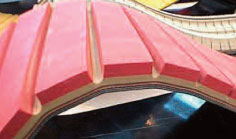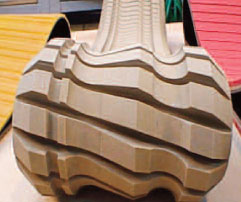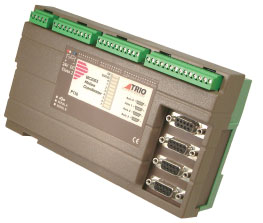The Issue
Telford-based manufacturer of toothed timing belts, Bondabelt, had problems with a special purpose machine for grinding slots in the back of its belts.
The machine was more than 10 years old, its Trio Motion Technology MC1 controller was obsolete, and the stepper motors driving the axes were unreliable causing the machine to lose position regularly. It had been made by a machine builder who was no longer able to support it and Bondabelt had no drawings or other information available for it.
 The machine has three axes of motion: X, Y and Z. The X-axis moves the belt along its own axis through the machine, the Y-axis moves the spindle across the belt and the Z-axis moves the spindle vertically. It has a conventional AC motor controlled by an inverter for driving the spindle at variable speed, which requires an analogue output from the controller to provide the speed demand signal into the inverter, plus handwheels for manually moving the Y- and Z-axes which also require two encoder inputs into the controller.
The machine has three axes of motion: X, Y and Z. The X-axis moves the belt along its own axis through the machine, the Y-axis moves the spindle across the belt and the Z-axis moves the spindle vertically. It has a conventional AC motor controlled by an inverter for driving the spindle at variable speed, which requires an analogue output from the controller to provide the speed demand signal into the inverter, plus handwheels for manually moving the Y- and Z-axes which also require two encoder inputs into the controller.
The belt is made in a continuous strip that is then cut to the required length and the ends joined to form a loop. The machine is used for grinding slots in the belt’s backing material, for stress relief so the belt is able to wrap around small diameter pulleys as well as for applications in which the belt is used for transporting products at equi-spaced intervals in the slots.
The Solution
I was able to trace the fault and repair it. However, after a number of visits, it became apparent that the problems were due to the fact that the motors were worn out and the control system outdated. To avoid Bondabelt having to go on paying for regular repairs – which would also have left them exposed to the risk that at some point the machine may fail and be impossible to repair, stopping production altogether – I recommended upgrading the drives and control system.
Giving an old machine a new lease of life
 The original machine had been fitted with open-loop stepper motors (that is, motors with no speed or positional feedback on their rotor which turns through a fixed angular increment in response to each pulse, or step, applied to its drive amplifier) for driving the X, Y and Z axes and had always suffered from the performance and positioning limitations of stepper motors. This problem was most apparent on long belts – the belt loop is mounted between pulleys on the machine with a piece of reflective tape attached to the backing, the belt is then driven one full revolution, determined by an optical sensor, to measure its length which is then divided into an equal number of increments at the required distance between slots. However, the fact that stepper motors move in fixed increments meant that there would usually be a cumulative error such that spacing between the first and last slots was unequal. Stepper motors also suffer from the problem that if they stall, even momentarily, because the load exceeds their peak torque the controller is unaware of this and the machine may continue operating with an offset error until either a collision occurs or someone notices that the products are faulty. Consequently, I offered Bondabelt two options – to replace the existing motors with stepper motors, or to fit servo motors which benefit from having higher dynamic performance than stepper motors and are fitted with a feedback device that continuously provides information about rotor speed and position, which is used by motion controllers for determining axis position. Although the servo system cost more than the stepper system, the benefits far outweighed the additional cost, as a consequence of which Bondabelt chose this option. I built a new control panel that was fitted to the machine during a shutdown. They rewired the machine, and made mounting plates for the Panasonic 750W servomotors.
The original machine had been fitted with open-loop stepper motors (that is, motors with no speed or positional feedback on their rotor which turns through a fixed angular increment in response to each pulse, or step, applied to its drive amplifier) for driving the X, Y and Z axes and had always suffered from the performance and positioning limitations of stepper motors. This problem was most apparent on long belts – the belt loop is mounted between pulleys on the machine with a piece of reflective tape attached to the backing, the belt is then driven one full revolution, determined by an optical sensor, to measure its length which is then divided into an equal number of increments at the required distance between slots. However, the fact that stepper motors move in fixed increments meant that there would usually be a cumulative error such that spacing between the first and last slots was unequal. Stepper motors also suffer from the problem that if they stall, even momentarily, because the load exceeds their peak torque the controller is unaware of this and the machine may continue operating with an offset error until either a collision occurs or someone notices that the products are faulty. Consequently, I offered Bondabelt two options – to replace the existing motors with stepper motors, or to fit servo motors which benefit from having higher dynamic performance than stepper motors and are fitted with a feedback device that continuously provides information about rotor speed and position, which is used by motion controllers for determining axis position. Although the servo system cost more than the stepper system, the benefits far outweighed the additional cost, as a consequence of which Bondabelt chose this option. I built a new control panel that was fitted to the machine during a shutdown. They rewired the machine, and made mounting plates for the Panasonic 750W servomotors.

Trio MC206 motion coordinator
I chose Trio’s latest model MC206 motion coordinator and uploaded Bondabelt’s existing applications programmes into it, so that the machine was ready for production when they returned after the two-week shutdown. Bondabelt were extremely pleased with the result, not only because it was achieved within the allotted timescale but because the new controller offered increased functionality that the machine had previously lacked – a great success at a fraction of the cost of a new machine!
The value to Bondabelt of my Contribution:
- Quick initial response to their requests for breakdown assistance
- Identifying and resolving the immediate problems to get them back into production
- Offering fair and reasonable advice about upgrading the obsolete controller to the latest model and upgrading the axis drives from stepper motors to servomotors
- Making the necessary mechanical and electrical modifications to fit the new servomotors and drives
- Uploading the existing applications programmes from the old controller into the new one, then re-commissioning the machine and making it work
- Completing the work in the shortest time possible – downtime costs money




Follow Tim!